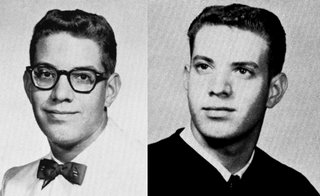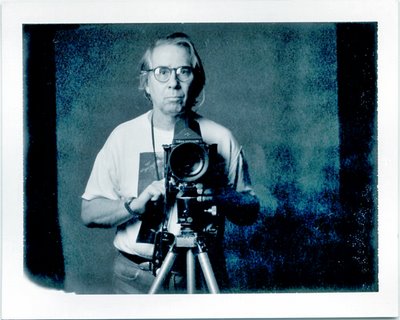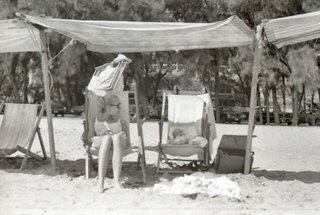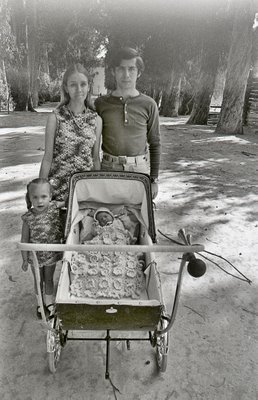Letting Go Of Rebecca While Not Telling All
Saturday, January 03, 2009
 I last saw Lee Lytton when we both graduated from St Ed's High School in 196l. It was only a couple of weeks ago that I finally located him and the emails have been going back and forth fast and furious. In his last email Lee wrote this: I'm still trying to patch together some things about your early history so that I can fit what I remember about you from almost 50 years ago into my recollections. I hope I'm not getting too personal, but I'm operating under the assumption that since your blogs are remarkably uninhibited and about as open a window into your past as I can imagine, you don't mind filling in a few more gaps.January 20th will mark the third year that I have posted a blog every day. At first I had no idea what blogging was all about. It took a while to figure out the mechanics of fitting pictures with copy. It was my eldest daughter Ale (40) who about a year and a half ago told me, "Papi I was sometimes afraid to ask you about your past and our family. Now, thanks to your blog it is all there." I really appreciated that as it gave me at least one goal. It is a goal that is similar to Rosemary asking my mother to write in white ink under the old photographs of our family albums. They are pasted with black corners on black paper. My mother's neat handwriting (a nun's school in Manila) will keep the people in the pictures alive for a few more generations until distance takes its toll and memory fades. This blog which is part of Blogger (purchased by Google some years ago) means that when people that I mention Google themselves, more often than not they find me. And this is how I find them. My blog has helped me as well as Lee to fit gaps in my memory of the people that have passed through my life. These people remind me of the experience of leaving in a train from Retiro Station in Buenos Aires. Sometimes our train left the platform as the same time as another. Both would follow parallel tracks but sooner or later one would give way or we would reach a fork where each train would bifurcate in an opposite direction. Lee and I were together for four years but we weren't really friends. I was much younger for my years while Lee was less shy and as soon as he got rid of his thick glasses he became popular with the girls. I had my glasses for the duration and I preceded the computer geeks in looks even though my interest lay in 4inch reflector telescopes and photographs of Lokheed F-104 Starfighters. But I do remember being in the back seat of Lee's 56 or 57 convertible Chevy in our last year. It was a thrill. To me Lee was the type who would write essays about women, cocktails and style for Esquire. That was not the case as he decided to become a prestigious professor of law. I am a bit taken aback by Lee's statement, "your blogs are remarkably uninhibited and about as open a window into your past as I can imagine..." His statement will not prevent me from trying to answer all his questions. But it does make me think that if Lee and I played poker I would lose my shirt in no time. These West Texans can keep their cards real close to their chest. Perhaps he is right. My wife Rosemary does not have an have an opinion as she has made it a point not to read my blogs. The only one who has protested about my candid approach has been Rebecca who says I reveal all her faults to the world. She says I embarrass her all the time, and has stictly prohibited me from telling anybody, especially in this blog that she is interested in boys and in one in particular. So I will avoid that subject. But it really has been Rebecca and my relationship with her as her grandfather and friend who has been the focus of most of my thoughts here.  Of late it has been all about my sadness of seeing her grow up and becoming far less moldable to my wishes. She is becoming literally her own woman at 11. Just two days ago she informed that she will no longer "mope" for any of the pictures I take of her. She plans to smile. Today Lauren (6) spent the day with us and is sleeping over. Rosemary read to her. We had a leasurely dinner. At the table she said, "It is nice not to have Rebecca with us now. She is not shouting at you Papi. It is quiet." Perhaps it is time to let go, just a bit, of Rebecca and take advantage while Lauren is still some years away from the distraction of boys, iPods and video games.  But I will not forget nor can I forget that without Rebecca in my life my blog would have never gone past a few months. Thank you.
Flinging Monkeys & Linearity Bites The Dust
Friday, January 02, 2009

Warning. A good measure of pontification follows.
The last days between Christmas and New Year's have always been lazy days of introspection and reflection. At this time, time, more than ever before in my life, I have been thinking about how our changing times are not ordinary changing times.
In the 50s and 60s American cars thrived on the idea that one year's model would be completely different from a previous year's. Inside, most of these cars were all the same. The technology was simple, almost crude. Newness was associated with the shape of grills and the height of a tail fin. I read ads about the "all new" 2009 Audi A-4 and noted that the outside is not all that different from our own two year old Audi A-4. Chances are, that mechanically our car and the new one are very different under that pretty Germanic skin of steel.
At one time cars were vehicles that took one and perhaps a few more from point A to point B. Versions of it were used for killing as was the WWI tank or a WWII Jeep with a mounted .50 caliber machine gun. I remember so well a copy of a 1943 Life Magazine that featured an ad for Buick that read, "Our Sherman tank features a Buick Dynaflow transmission."
During this time telephones were for communication between considerable distances or from one side of a city to another. Typewriters were for typing novels, personal letters, job applications, recording births and deaths or sending you to jail for an eventual and terminal execution (if you happened to be a murderer).
That period of our world (slowly breaking up now) had been determined really by one man, Johannes Gutenberg in the 15th century. His bible and the printed books that followed established an order of things related to a beginning and an end. This linearity brought into being the preface, the index, the bibliography and footnotes. To this day some Spanish (who have their own idea of linearity) books have the índice at the end!
This linearity has also imposed a logic that things have a purpose and one purpose only. A hammer might be used for hammering nails, for removing them and in a pinch (if carefully wrapped in a rag) to firm up a rickety chair. The screwdriver is used for tightening and loosening screws. But it doesn't take too much imagination to think that the screwdriver could be used for making holes in a spring garden and to drop seeds in them.
It took precocious teen agers (as soon as they could borrow dad's) that cars could be used for the privacy of illicit sex. It didn't take long for bank robbers to realize that a car was a far better method of getting away from the bank than a horse.
For me the two most important events of the 20th century were the contraceptive pill and the photograph of our earth hovering on the horizon of the moon taken by Apollo 8 astronaut Bill Anders in 1968. At last we could point down and say, "We are from there." And the former, the pill, more than the "death of God" did away with most of the morality and the imposed shackling of women in their quarters which is central to just about every religion.
Perhaps in this century the breaking up of linearity will be the most important event. An inkling of this came with Argentine author Julio Cortázar's 1963 novel Rayuela (Hopscotch) which could be read logically from beginning to end but the author also had some non linear suggestions that involved skipping chapters randomly. I would predict here without any doubt that in an extremely near future the Amazon Kindle will feature not only an on line dictionary but also hypertext. This means that a Scheherazade of the future will be able to keep her Persian king interested far more than those one thousand and one nights. In a soon-to-be released science fiction version of this book by Chip Gibson, the story will never end and will only be able to be published by Borges's infinite library.
All the above blabber came to mind today after going to a new year's day at home at a friend's house. My friend does undisclosed work (not secret simply way over my head) at Sun Microsystems. Many of his guests were software engineers. One of them, Philip, had been a physicist before until he (a very smart man) saw were things were going to. "Physics and most of the sciences need funding," and it was obvious Philip was not going to wait or depend on that to promote his career.
He asked me if I remembered the old and primitive word processors. I told him I still had one although Word and my PC have replaced my Smith Corona PWP 40. "The problem with that device, is that its creators were still stuck on the idea of a typewriter and the little screen (about 3 inches wide). Phillip then ended the conversation with the buzz expression, "The end product has to be optimized."

Another of the cyber engineers told me that he no longer considered himself a programmer as he found it frustrating that most programs required more than one thousand words to work. "I am looking for an under 1000 word solution." Then while he was talking to someone else I heard him say, "A cathedral."
Most of those Gothic cathedrals were built before Gutenberg. The secret as to how they were built was not written down but lay in the minds of the masons who built them. The secrets were passed from one generation of masons to the next. As soon as engineering, architecture, law and medicine became a science the secrets could only be seen and understood in colleges and universities. Along with musicians who could read music these arts and professions became understandable only by those with the intellect to study. The rest of us were left out. The Masonic order now includes those cyber engineers that enable us to live our life, or not, with programs that they alone understand but programs we must absolutely must have.
Many of these programs are applications, a new buzzword that is now shortened to apps. Consider that since July Apple has posted more than 10,000 programs to its App Store. The most popular of them (it costs $0.99) lets the phone simulate the sound of flatulence.
While I believe that the real inventor of multitasking is old-fashioned Man, I can see that idea that a screwdriver could be used to plant seeds is about as primitive and idea as telling Alexander Graham Bell that his invention would enable people to talk to each other, nothing less and nothing more. If I told them that there is also an app called Sapus Tongue in which the user swings the phone to see how far he can fling an animated monkey on the screen he would probably change the subject to, "Who's that gorgeous woman at the Smith Corona PWP 40?"
My Audiovox Model CDM-8100PPP phone will not fling monkeys nor produce artificial flatulence. It is capable of getting and sending email but I have never bothered to use that feature. I use my Audiovox to talk to people.
More
And more
And even more
And more again
And more
And a bit more
And more
More?
And the last one
An Uncircumcised Heathen - An Epiphany
Thursday, January 01, 2009

I have written here before of my Filipino heritage. My mother was born in Manila. Some of our relatives are Filipino/Chinese with the surname Roxas. One of them, Manuel Roxas was the first president of the Philippines in 1946. My grandmother would often talk to my mother in Tagalog in my presence when I was a little boy to keep their conversations private. They knew I had a keen ear. By some osmosis of sorts I managed to learn some Tagalog and in particular the words that are useful.
In Vancouver we are lucky to have the Goldilocks bakery (Broadway at Fir) which features not only Filipino breads, cakes, desserts and food but such wonderful stuff as Magnolia macapuno ice cream. This is a coconut ice cream made from a sport of the coconut palm (some say it is a disease) harvested, primarily in the Philippines. They are sold in jars as "gelatinous mutant coconut" cut into balls or strands. In a macapuno coconut the water and the meat do not separate and they are one gelatinous mass. These coconuts are thrown away just about anywhere else. I have prevented Mexicans boys serving me an ice cold coconut at beaches in Acapulco, Veracruz and Isla Mujeres from throwing my chosen fruit away when they saw the nasty looking gelatin inside. It is delicious. My uncle Don Luís Miranda who worked for San Miguel Beer and Magnolia created the macapuno ice cream flavour. It is straight from heaven.
At Goldilocks I like to purchase Filipino shortbread called polvorones and a wonderful puffy bread called ensaymadas (from Spain via the Philippines). At Goldilocks the procedure is to place your order on a small sheet of paper with a small pencil that is provided (did Lee Valley copy them?). When I first started going to Goldilocks I would write Suput as my name. When my paper was picked there was a lot of stammering and or silence involved when the women behind the counters (they wear hair nets) tried to figure out who was the male of the species responsible for the joke.
In late 1967, shortly before I married Rosemary, I lived in Mexico City with an urbane Filipino, Raúl Guerrero Montemayor (first cousin to Ivette Mimiuex). Raúl is godfather to my youngest daughter Hilary. One of Raúl's friends, Nonong, was the playboyish son of Manuel L Quezon the first Filipino president of the Commonwealth of the Philippines under U.S. occupation rule in the early period of the 20th century. We became friends and he gave me the nickname of Suput. Even my eldest daughter's godfather, my Yorkshire-born friend Andrew Taylor calls me by that nickname to this day.
Now in Tagalog suput means literally tight but it also means uncircumcised. In a country that has been mostly Catholiic since Magellan but also Muslim, to be suput is to be unclean. It is a serious Filipino insult. You can imagine what goes through the minds of the Filipina women with their hairnets when they see my nickname. They know me now so they just giggle when they see me and ask me what I want. They have another nickname for me, Andong, which is a much cleaner and it is a re-working of Alexander.
Since I was raised as a Catholic and I went to a very good Catholic school, St. Edward's in Austin, Texas I know that today is the Feast of the Circumcision. It is a feast that is fairly low in the order of Catholic feasts. A much more important feast is the one that falls on January 6. At the Epiphany, the visit by the Magi on the infant Jesus has a tremendous symbolic and religious importance. God had made an exclusive contract with the Israelites of the Old Testament. By the simple act of having the Magi (no matter how regal they might have been they were still unclean, uncircumcised heathens) visit the manger it represented a new order of things, the New Testament. Not only the Israelites but all baptized mankind (the males could be either circumcised or not) now had the opportunity to sit on the right hand of God in heaven.
The heathen above is a self portrait taken mid December 2008 with b+w Polaroid.
A Butterfly Flies In From Paris - Par Avion
Wednesday, December 31, 2008
I phoned Rebecca and said,"¿A qué no sabés lo que llegó hoy?" (Guess what arrived today.) Her answer was quick, "Llegó el regalito de Homero." (Homero's little gift arrived.)
That yearly and pleasant routine while not exactly on schedule this time (the snow?) was delivered yesterday. Homero Aridjis, the butterfly man, the man who loves butterflies, came through with his little present, all the way from Paris. In the envelope there was a Mexican tin Christmas ornament. It was a most unusual one as this is the first butterfly Aridjis has ever sent me. It has to be special. How many get a butterfly to fly all the way from from Paris (Par Avion) on December 30 when the snow outside is not melting?
The little ornament, which will hang with all the other tin ornaments from a string of red yarn on the front living room window by the Christmas tree, made me want to look into one of my favourite books by Aridjis, ¿En Quién Piensas Cuando Haces El Amor? (In whom do you think when you make love?) Alfaguara, 1995. This novel is about a Mexico City in a scary future based on a very scary present when pollution is killing the great cypresses of Chapultepec Park and birds plummet from the sky like stones. The narrator of the novel, Sanchez is present when María, twin sister to Rosalba finds out that Rosalba has died. Rosalba and Sanchez go to the burial.
Perdí noción de la hora, había dejado mi reloj de pulsera en el bolso y el bolso en la recámara de Rosalba. Una mariposa se posó en mi frente. La cogí con la mano.
Delante de nosotros pasaron docenas de mariposas monarcas. No las veía desde mi infancia. Desorientadas anduvieron entre las tumbas y los árboles muertos, quizás en busca de agua. Una de ellas, como sobreviviente de la extinción biológica y como fantasma de migraciones pasadas, fuera de lugar y de tiempo, se posó en el pelo de María.
I lost all notion of time, I had left my wrist watch in my bag and the bag in Rosalba's bedroom. A butterfly alighted on my brow. I caught her with my hand.
Dozens of monarchs flew by. I had not seen them since my youth. Lost they flutterd among the tombstones and the dead trees. Perhaps they were looking for water. One of them, like a survivor of a biological extinction and like a ghost of past migrations, out of place and time, rested on María's hair.
I have read this beautiful passage so many times but only today did I bother to look up the origin of the Spanish mariposa. Hidden in the word is "pose for me Mary". The verb posar in Spanish has the double meaning to pose and to rest.
The arrival of the little tin butterfly made me think that somehow, while a little bit early for her spring migration, she is a monarch that knows where home is.
Goh For Gold (Cultural) In 2010 Olympics
Tuesday, December 30, 2008
 An open blog to VANOC's Cultural Olympiad Czar Robert Kerr (left) In November 2007 I read with interest and some degree of optimistic pleasure this article in my Vancouver Sun. Since then I have begun to feel some anxiety and have felt a tad depressed about it. It was only last week that while talking to someone (an important player in our city's cultural affairs) about who was going to appear in our 2010 Cultural Olympics that I realized I had a good reason to feel that anxiety and depression. This is what she said, "When VANOC announced its plan in 2007 and how cultural organizations could apply for participation many of us saw too many barriers and much bureaucracy. So we just didn't bother to apply." I am not quite sure she is right or that VANOC is as terrible a monolithic organization as some think. I know for a fact that they have been instrumental in helping fund the Pacific Baroque Orchestra's program to bring music to the Vancouver East Side with its free concerts at St James Anglican. There is a funny word in Spanish, much funier than its English equivalent laughingstock. It is hazmerreír or literally "make me laugh". I am beginning to believe that our cultural Olympics might just make us the hazmerreír of the world. Consider the following which are not in any special order and probably heavy into dancing since I am heavy into dancing. I saw them all and probably many more that with the fading memory of my age I have ovelooked but many who might read this will point them out. Will any be part of the cultural Olympics? Trout Stanley by Claudia Dey Trout Stanley is a play about the Canadian (BC) North produced by our local Ruby Slippers. This play won many awards in spite of being most entertaining and funny. To top it all it had a cast that featured some of our best actors including Jonathon Young and Lois Anderson. Studies in Motion: The Hauntings of Eadweard Muybridge by Kevin Kerr, Electric Theatre Company No Exit by Jean-Paul Sartre, Electric Theatre Company Both plays directed by Kim Collier would make Vancouver proud. Studies in Motion incorporated choreographer Crystal Pite. I can make the blanket statement that anything by or with Crystal Pite is worth watching. His Greatness by Daniel MacIvor - Arts Club Theatre Company His Greatness a play about Tennessee William's days in Vancouver shortly before he died combines stuff that would appeal to an international jet set audienced yet show a bit about our city. This play was produced by the Arts Club. The Matka King and Bombay Black both by the Arts Club Theatre Company Both these plays performed by the Arts Club Theatre Company are very Indian yet in many ways very Canadian by an Indian playwright and novelist of note Anosh Irani. The Magic Flute by Mozart - Vancouver Opera This Vancouver Opera production with dazzling sets and a setting production centered in the world of the North West coast aboriginal community is an opera that would be acclaimed for its originality anywhere in the world. There are many young Native Canadian singers who can sing the parts including Melody Mercredi. Naomi's Road- Vancouver Opera This accessible opera based on Joy Kogawa's internment in a camp in BC during World War II and with music by young local composer Ramona Luengen is an opera that my 9-year old granddaughter loved but also managed to entertain me. I wonder how much of VANOC's cultural olympics will appeal to children? Game Misconduct - Presented by Festival Vancouver in association with the Vancouver Playhouse Theatre Company This contemporary hockey opera with music by Leslie Uyeda and librettist Tom Cone with music performed by Standing Wave was a terrific comedy on how Canadians view hockey as an essential part of their lives. The re-mounting of this opera would also show off the musical brilliance of Standing Wave. The Goldberg by John Alleyne This 1998 look at Bach's Goldberg Variations as interpreted by a modern ballet company, Ballet BC was a revelation. It's use of recorded music could be improved (see below) to make this John Alleyne ballet a masterpiece. The Goldberg Variations by a string trio. Some years ago I attended a concert in which a string trio playing period baroque intstrments played an orchestration of Bach's Goldberg Variations. It was an evening of fun and wonder. The trio was composed of members of the Pacific Baroque Orchestra, violinist Paul Luchkow, violist Angela Malmberg and cellist Laura Kramer. I would love to watch Alleyne's The Goldberg with live music by this trio. The Faerie Queen John Alleyne and Ballet BC This is another terrific John Alleyne piece for modern ballet that explores Purcell's music as adapted by two of Vancouver's most noted new music composers Michael Bushnell and Owen Underhill. EDAM with Peter Bingham Peter Bingham's brand of contact improvisational dance is cutting edge dance that is still accessible and fun. A collaboration by Bingham and Crystal Pite, Vanishing Point is memorable for me as one of the most dazzling displays of theatre/dance I have ever seen. Brief Encounters & Dances for the Small StageBoth of these separate dance organizations Brief Encounters and Day Helesic's Dances for a Small Stage offer small stand alone dance performances that mix various media and can be performed in minium space to alll audiences. Many Vancouver choreographers of note have been involved with Dances for a Small Stage. Anything by Choreographer Jennifer MascallBut especially a production of her dance The Brutal Telling based on the life of BC artist Emily Carr. Anything by Karen Jamieson Dance.More than anybody Karen Jamieson has worked hard to fuse modern dance forms with elements of Canadian aboriginal dance and aboriginal culture. Blood Alley by Byron Chief-Moon I have seen Byron Chief-Moon dance with the Karen Jamieson Dance Company but this solo performance of his is dramatic and thrilling. Fan Dance by the Goh Ballet Just a few months ago I saw a fan dance at the Goh Ballet that incorporated both Asian and non Asian dancers. It was terrific to hear those large fans open and close. I cannot think of anything more appropriate to show off our multiculturalism. Anything involving dancer/choreographers Shay Kuebler, Amber Barton Funk and Josh Martin. These three dancer/choregraphers have fused modern dance to hip-hop and produced an amalgamation that works and is exciting, too. Slab by choreographer Chick Snipper This startling dance based on 16th century anatomist Andreas Vesalius incorporated new music with musicians like the internationally renowned local cellist Peggy Lee. Anything by Bard On The BeachThere is nothing like Christopher Gaze's Bard On the Beach anywhere else in the world that has the setting of Vancouver as a back stage. The Borealis QuartetI saw a performance of this quartet of young virtuosi at the Dr. Sun Yat-Sen Chinese Classical Garden last year. A superb group in a superb setting. Anything by the Vancouver Symphony and Bramwell Tovey. Anybody who can pass muster with the critical audience of New York City would surely delight the world that is coming to us during the 2010 Olympics. Blod Mixes Inside My Heart by Kevin Loring -Vancouver Playhouse This play set in Lytton BC was a wonder to watch and listen to. Kevin Loring's play is a must. Three Sixty Five by Wen Wai Wang This modern dance piece by Wen Wai Wang and his company featuring a musically deconstructed score of Vivaldi's Four Seasons and performed with cellist Peggy Lee was Vancouver dance at its most avant-garde. Anything by Kidd Pivot's Crystal PiteVancouver Jazz. I could think of many but these young performers come to mind besides our city's one and only Brad Turner. There is Amanda Tosoff and Cris Derksen. The Pacific Baroque OrchestraSome years ago the PBO under the helm of virtuoso violinist Marc Destrubé organized a spectacular concert at the UBC First Nations Longhouse that featured baroque (proto ballet) dancers in juxtaposition to contemporary (17 century) First Nations dance. Mr. Kerr is it too late to incorporate any of these acts?
Magic, A Red Schuco, Alfonso Cuarón & Mervyn Fernandez
Monday, December 29, 2008
 From when I can remember I can recall asking my father, "Tell me a story." And in Spanish my cousin Wency and I would ask his father, "Contanos un cuento de piratas, de espadachines o de conbois." (Tell us a story about pirates, deft swordfighters or cowboys.) Today's blog begins at the dinner table. Lauren started with, "Papi how do you say chicken in French?" For a long time I have been giving her "le shiken" with my best French accent. Lauren has given up telling me that the correct word is poule and simply says with a fair degree of accuracy, "You don't know how to speak French." This time Rebecca did not stay out of the conversation and agreed with Lauren that poule was the right term for chicken. I immediately got up from the table to fetch from my living room library my copy of Through the Looking-Glass - And What Alice Found There, and read to them: 'When I use a word,' Humpty Dumpty said, in rather a scornful tone, "it means just what I choose it to mean - neither more nor less.'
'The question is,’ said Alice, 'whether you can make words mean so many different things.'
'The question is,’ said Humpty Dumpty, ‘which is to be master - that's all.'Rebecca then asked me, "So is le shiken correct?" I attempted to fudge but I finally said, "For me it is," and added, "the important thing to learn is that we must take control of the words in our vocabulary and not let them rule us." I could have added but she would not have understood, "A synonym is a word you use when you don't know how to spell the other one." What all the above has to do with story telling is that this afternoon we sat down to view a DVD of a film I carefully chose last night. It is Mexican Alfonso Cuarón's version of the often filmed story A Little Princess by Frances Hodgson Burnett. This 1995 film has minor special effects only in some wonderful dream sequences. The rest of it hinges on acting, and the idea that magic happens if you believe in it. It is a magic of the imagination and both of our little granddaughters, Rosemary and I had to imagine that a bare and ugly attic became a little Hindu palace overnight because of an intriguing Indian manservant with a monkey on his shoulder. While we had enjoyed the previous evening's viewing of Pixar's WALL-E, here was a film in which just the story was sufficient to please two cynical adults and two soon-to-be cynical children. The little girl in A Little Princess has a penchant for telling stories. And from her father she has learned that magic exists if you believe in it. I was 8 and Santa Claus had brought me a red Schuco racer (about 15cm long) with steering, suspension and a gear shift that worked! I was driven by a windup mechanism which needed a large key. Within the hour I had lost the key and loudly cried to my father that all was lost and that I wanted to die. With a smile on his face he told me, "Alexander, Santa Claus knew this was going to happen so he entrusted me with an extra key. Here it is." To me this was pure magic and I have never forgoten it. I absolutely despise little boys (they are never little girs) who try and figure out a magician's tricks during a performance. And when they think they know, they loudly proclaim the fact to those who still believe in magic.  Mervyn "Swervin Mervyn" Fernandez was a fantastically slippery wide receiver for the BC Lions around 1985 when I photographed him. For the picture I wanted to show how Fernandez seemed to have some sort of magical magnetism in his hands that could attract and catch a football even if the pass was a bad one. For the shot I used a black coat hanger wire which was attached as a belt around Fernandez's waist and clamped on to the ball with expoxy glue. To me my trick was simple yet now, in 2008, the trick would be a lot simpler and perhaps because of it less believable since I would use Photoshop. After seeing Cuarón's beautiful A Little Princess I understand more than ever that a child's imagination is something that has to be nurtured and preserved. The power of story telling seems to be waning as th special-effects-reality of films and games is seen as better, more colourful and more exciting. Who knows while Rebecca might think she is too old for this kind of thing there is still a chance that Lauren, just might soon ask me to tell her a story. The problem is, if not cowboys, pirates and deft swordfighters, then what?
An iPod, A Shuffle Setting & Memory Of A Christmas Past
Sunday, December 28, 2008
 Last night as I was telling Rosemary of my efforts to locate my fellow classmates from St Edward's High School in Austin( 1957-1961) because of a first ever reunion in June she told me, "Alex you are living in the past." There have been other reunions at St Ed's that have incorporated the high school (1925-1972) with St Edward's University which, unlike our Texas Landmark of a school, is still going strong. The significance of the June reunion is that it is only for the high school. My search for fellow classmates has taken me to an adobe brick factory in Alcade, New Mexico and to the story of a young 22-year-old man who was a car jockey at the LAX Airport. He had to park Tony Curtis's Maserati. While driving it he saw a fruitless future. He saw the light and quit his job. He went into law school and now teaches law in San Antonio. My search took me to the lore and history of the King Ranch (the largest ranch in the US) as I tried to figure out exactly who Michael East was in this scheme of things. This story involves a heiress who is befriended by a priest who convinces her to change her will so that the money would go to his order as opposed to the Diocese of Chorpus Christi and her heirs. A big lawsuit ensued and the presiding judge was the man whose son saw the light while driving the Maserati. Of Michael East I remember a young man with strange eyes (was one green and the other blue?) who wore jeans with spurs, a cowboy hat the first time I ever saw him. He was quiet-spoken, gentle and kept to himself. Why had he come to St Ed's?  When Rosemary told me of my living in my past I was left speechless (for a moment). This interest of mine in my relationship with classmates from a boarding school whom I have not seen since 1961 has kept me occupied these last few days. I am about to finish Umberto Eco's novel The Mysterious Flame of Queen Loana which I am sure is partly an autobiography of Eco and particularly of his childhood under Mussolini.  The explanation of the novel on the back cover is as follows: Yambo, a sixtyish rare-book dealer in Milan has suffered a loss of memory - he can remember the plot of every book he has ever read, every line of poetry, but he no longer knows his own name, doesn't recognize his wife or his daughters, and remember nothing about his parents or his childhood. In an effort to retrieve his past, he searches through boxes of old newspapers, comics, records, photo albums, and adolescent diaries. And so Yambo relives the story of his generation: Mussolini, Catholic education and guilt, Josephine Baker, Flash Gordon, Fred Astaire. His memories run wild, and life races before him in a series of images, as Yambo stuggles to capture one- that of his first love. My retort to Rosemary's troubling comment was one where I related my reading of Lawerence Durrell's Alexandria Quartet (Justine, Balthazar, Mountolive, Clea) and how these novels present four perspectives on a single set of events and characters in Alexandria, Egypt, before and during World War II. The Quartet are an exploration of relativity and the notions of continuum and subject-object relation, with modern love as the subject. The Quartet offers the same sequence of events to us through several points of view, allowing individual perspectives to change over time. I explained to Rosemary that examining the lives of all these boys now is like looking at my own life from a different point of view. I have written here of Julian Barnes's book nothing to be frightened of. In it he relates of his journeyd from atheism to agnosticism. In grade 11 my fellow classmate John M. Straney (now dead) began to loudly proclaim (in our Catholic boarding school) that he no longer believed in the existence of God. I remember arguing with him to no avail. I remember bringing him to the presence of Brother Edwin Reggio CSC who taught us religion and saying to Brother Edwin, "John says he no longer believes in God." Somehow Brother Edwin never took him to task and played a duck in the rain. I am sure other schools would have summoned the boy's parents and then expelled him. Nothing like this happened.  I am now able, especially in these wonderfully lazy days between Christmas and the Epiphany (January 6) to contemplate all these events of my past and reconcile them to my present. From there I can resolve how those past events will form or decide my future. The photos in today's blog are from my past. But they are strange in some ways that remind me the shuffle tab of my Sony CD player. This shuffle device ushered in the random playing possibilities of my Rebecca's new Christmas iPod. The iPod and the demise of long playing albums and the eventual dissapearance of the CD are all about to destroy the order of first page first and last page last that Gutenberg's press brought to us in 1439. The photos in today's blog are the product or a personal custom of my era in the 60s when I would keep a 36-exposure roll in my camera for months. I would then process it months later and cut the strips into frames of 6, not taking into consideration subject matter or seasons of the year. In two pages of negatives I have here a selection of our first 1968 Christmas in Veracruz with our four-month old daughter Alexandra Elizabeth and a last picture featuring the four of us with the newborn Hilary near our house in Arboledas in 1972. In between there are pictures of my mother with Ale and of my Aunt Dolly with Ale and even one of my mother's dog, a boxer called Antonio with the owner's son. Christmas in Veracruz were obviously hot as there is a picture here of Rosemary on Mocambo beach sitting with a tiny Ale under an awning.  When Ale was born in August of 1968 we traveled to Veracruz a few weeks later in our VW bug to show of the kid to my mother. On the way I slipped off a curve (I was driving too fast) and turned over. We were saved by new-fangled seat belts that had come with the purchase of two new Firestone tires. Ale was saved because she was in a hooded wicker basket in the back seat. The hood saved her. Some farmers turned the car right side up and I slowly drove the lopsided vehicle to a worried mother who was anxiously waiting for us.  A few weeks later she visited us in Mexico City and told us we needed an English pram. She picked up the daily News a Mexico City paper in English) found a used pram. We went to see it and promptly bought it. We were delighted with the elegant dark blue lacquer finish on the wood body. My old negative book has no obvious order. It is a 1968-1972 shuffle that in an unsettling way (I feel that unsettling now) predicted an era when one will no longer be able to say, "If you think this cut is nice wait until you hear the next one." How will that iPod affect Rebecca's memories in a near future? I look back and I can remember with a luxury of detail Dan Sherrod's album The Gibraltar Grand Prix in which Peter Ustinov was the voice of all the drivers (the German, the Frenchman, the Italian, the Aregentine and also all the special effects noises of the cars). I remember it all in the "correct" order. I feel no different from Umberto Eco's Yambo who is looking into old boxes to make some sense from his past from a forgotten present.
|























